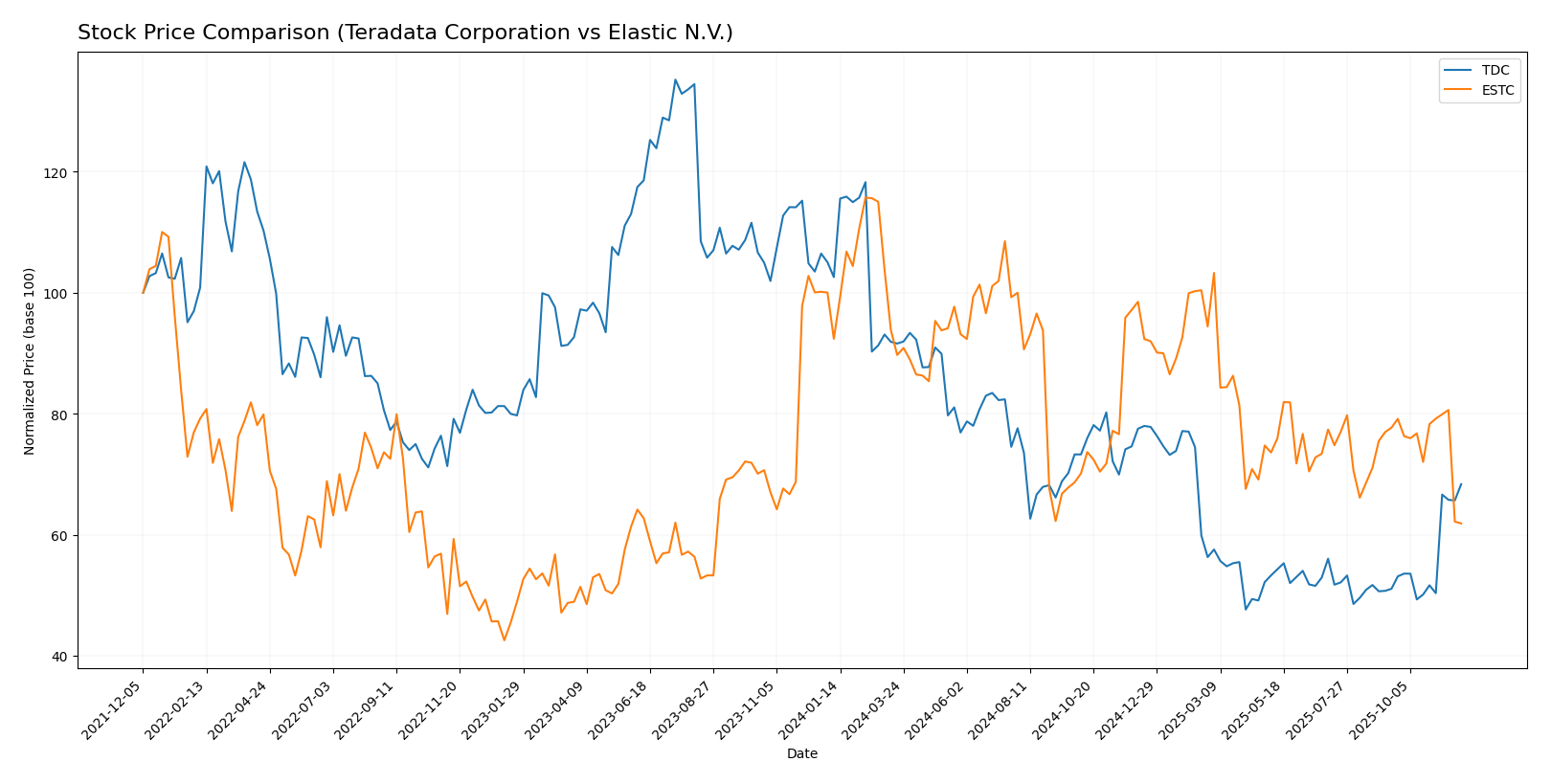In the dynamic landscape of technology, two companies stand out for their innovative approaches to data management and analytics: Teradata Corporation (TDC) and Elastic N.V. (ESTC). Both firms operate within the software industry but focus on different aspects of data solutions—Teradata emphasizes infrastructure, while Elastic specializes in application-level services. This comparison will dive into their unique strategies and market positioning, helping you identify which company might be the more compelling investment opportunity.

Table of contents
Company Overview
Teradata Corporation Overview
Teradata Corporation, founded in 1979 and headquartered in San Diego, California, specializes in providing a connected multi-cloud data platform for enterprise analytics. Its flagship product, Teradata Vantage, allows businesses to leverage their data across various sources, simplifying the data ecosystem and facilitating cloud migration. Teradata’s consulting services help organizations establish a robust data and analytics strategy, ensuring their infrastructure delivers tangible value. The company caters to a diverse clientele across sectors such as financial services, healthcare, and telecommunications, highlighting its integral role in the data analytics landscape. With a market capitalization of approximately $2.72B, Teradata demonstrates a commitment to innovation in the technology sector.
Elastic N.V. Overview
Elastic N.V., incorporated in 2012 and based in Mountain View, California, offers technology solutions that are designed for both public and private cloud environments. The company is best known for its Elastic Stack, a suite of products that enables the ingestion, storage, and analysis of data from various sources. Key components include Elasticsearch, Kibana, and Logstash, which collectively provide real-time search, analytics, and data visualization capabilities. With a market capitalization of around $7.43B, Elastic serves a wide range of applications, from logging and metrics to application performance monitoring, positioning itself as a leader in the software application industry.
Key similarities and differences
Both companies operate within the technology sector but focus on different aspects of data management. Teradata emphasizes enterprise-level analytics and multi-cloud integration, while Elastic centers on search and data visualization solutions across various environments. Their distinct product offerings cater to varying needs within the data ecosystem, showcasing their unique positions in the market.
Income Statement Comparison
The following table provides a comparison of key income statement metrics for Teradata Corporation and Elastic N.V. for their most recent fiscal years.
| Metric | Teradata Corporation (TDC) | Elastic N.V. (ESTC) |
|---|---|---|
| Market Cap | 2.72B | 7.44B |
| Revenue | 1.75B | 1.48B |
| EBITDA | 293M | 6M |
| EBIT | 193M | -6M |
| Net Income | 114M | -108M |
| EPS | 1.18 | -1.04 |
| Fiscal Year | 2024 | 2025 |
Interpretation of Income Statement
In the most recent fiscal year, Teradata Corporation reported a steady revenue of 1.75B, slightly down from the previous year, while Elastic N.V. saw an increase in revenue to 1.48B from 1.27B in 2024, indicating growth. However, Teradata’s net income of 114M highlights profitability, contrasting with Elastic’s net loss of 108M. Margins varied significantly; Teradata maintained stable margins, while Elastic faced operational challenges resulting in negative EBIT and EBITDA. Overall, Teradata demonstrates resilience, while Elastic needs to address its financial difficulties to return to profitability.
Financial Ratios Comparison
In this section, I will present a comparative analysis of the financial ratios for Teradata Corporation (TDC) and Elastic N.V. (ESTC) based on the most recent data available.
| Metric | TDC | ESTC |
|---|---|---|
| ROE | 85.71% | -116.60% |
| ROIC | 16.89% | -11.80% |
| P/E | 26.34 | -82.65 |
| P/B | 22.58 | 9.64 |
| Current Ratio | 0.81 | 1.92 |
| Quick Ratio | 0.79 | 1.92 |
| D/E | 4.33 | 0.64 |
| Debt-to-Assets | 33.80% | 22.95% |
| Interest Coverage | 7.21 | -2.17 |
| Asset Turnover | 1.03 | 0.57 |
| Fixed Asset Turnover | 9.07 | 51.28 |
| Payout ratio | 0% | 0% |
| Dividend yield | 0% | 0% |
Interpretation of Financial Ratios
Analyzing the ratios, TDC demonstrates strong performance metrics with a solid ROE and ROIC, indicating effective management and profitability. In contrast, ESTC’s negative ratios, particularly its high debt-to-equity ratio and negative P/E, point to significant financial distress and potential risks. This raises concerns about its sustainability and investment viability. Overall, TDC appears to be the stronger candidate for investment compared to ESTC.
Dividend and Shareholder Returns
Both Teradata Corporation (TDC) and Elastic N.V. (ESTC) do not pay dividends, reflecting a focus on reinvestment and growth strategies. TDC, with a dividend payout ratio of 0, allocates its resources primarily to capital expenditures and operational improvements, aiming for long-term value creation. Similarly, ESTC has no dividends, indicating a commitment to R&D and scaling operations. Both companies engage in share buyback programs, signaling confidence in their future potential. This absence of dividends, accompanied by strategic reinvestments, may ultimately support sustainable long-term shareholder value.
Strategic Positioning
In the competitive landscape of the technology sector, Teradata Corporation (TDC) holds a market cap of $2.72B, offering its multi-cloud data platform, Teradata Vantage, which is critical for enterprise analytics. Elastic N.V. (ESTC), valued at $7.44B, excels with its Elastic Stack, a robust suite for data ingestion and analysis. While both companies face intense competitive pressure and potential technological disruptions, Teradata’s focus on enterprise-scale solutions contrasts with Elastic’s versatile approach, catering to diverse data needs across cloud environments.
Stock Comparison
In this section, I will analyze the weekly stock price movements of Teradata Corporation (TDC) and Elastic N.V. (ESTC) over the past year, highlighting key dynamics and price fluctuations that have shaped their performance.

Trend Analysis
Teradata Corporation (TDC) Over the past year, TDC has experienced a price change of -32.6%, indicating a bearish trend. The stock price reached a high of 48.99 and a low of 19.73, demonstrating notable volatility with a standard deviation of 7.27. Recently, from September 14, 2025, to November 30, 2025, the stock showed a significant recovery with a 35.41% increase, although the overall trend remains downward with acceleration in the longer term.
Elastic N.V. (ESTC) ESTC has similarly faced a challenging year, with a price change of -32.25%, which also classifies it as bearish. The stock hit a high of 130.39 and a low of 70.04, with a standard deviation of 14.9, indicating substantial volatility. In the recent period from September 14, 2025, to November 30, 2025, ESTC’s price decreased by 19.43%, reflecting a trend of deceleration.
Both stocks have demonstrated increasing trading volumes, with TDC showing a buyer percentage of 54.74% and ESTC at 57.92%, suggesting a slight buyer dominance in the market. However, caution is advised due to the prevailing bearish trends in both companies.
Analyst Opinions
Recent analyst recommendations for Teradata Corporation (TDC) indicate a strong buy with a B+ rating, supported by solid scores in return on equity (5) and discounted cash flow (4). Analysts highlight TDC’s robust financial health and growth potential as key reasons for their positive outlook. In contrast, Elastic N.V. (ESTC) has a C- rating, signaling a sell, primarily due to weak performance metrics across multiple categories, including return on equity (1) and price-to-earnings ratio (1). Overall consensus for TDC is a buy, while ESTC is viewed as a sell.
Stock Grades
Here’s an overview of the recent stock grades for Teradata Corporation (TDC) and Elastic N.V. (ESTC), provided by reputable grading companies.
Teradata Corporation Grades
| Grading Company | Action | New Grade | Date |
|---|---|---|---|
| Citizens | upgrade | Market Outperform | 2025-11-10 |
| Evercore ISI Group | maintain | Outperform | 2025-11-05 |
| Barclays | maintain | Underweight | 2025-11-05 |
| TD Cowen | maintain | Hold | 2025-11-05 |
| UBS | maintain | Neutral | 2025-08-06 |
| Guggenheim | maintain | Buy | 2025-05-07 |
| Barclays | maintain | Underweight | 2025-04-21 |
| Citizens Capital Markets | maintain | Market Perform | 2025-03-18 |
| JMP Securities | maintain | Market Perform | 2025-02-13 |
| RBC Capital | maintain | Sector Perform | 2025-02-12 |
Elastic N.V. Grades
| Grading Company | Action | New Grade | Date |
|---|---|---|---|
| Citigroup | maintain | Buy | 2025-11-24 |
| JP Morgan | maintain | Overweight | 2025-11-21 |
| Piper Sandler | maintain | Overweight | 2025-11-21 |
| Cantor Fitzgerald | maintain | Neutral | 2025-11-21 |
| Wells Fargo | maintain | Equal Weight | 2025-11-21 |
| DA Davidson | maintain | Neutral | 2025-11-21 |
| Stifel | maintain | Buy | 2025-11-21 |
| Morgan Stanley | maintain | Overweight | 2025-11-21 |
| Truist Securities | maintain | Buy | 2025-11-21 |
| Guggenheim | maintain | Buy | 2025-11-21 |
Overall, TDC has seen a recent upgrade to “Market Outperform” from Citizens, indicating a positive shift in sentiment. Meanwhile, ESTC maintains a strong position with several “Buy” and “Overweight” ratings, suggesting continued investor confidence in its prospects.
Target Prices
The following target prices reflect the consensus among analysts for Teradata Corporation (TDC) and Elastic N.V. (ESTC).
| Company | Target High | Target Low | Consensus |
|---|---|---|---|
| Teradata Corporation (TDC) | 24 | 24 | 24 |
| Elastic N.V. (ESTC) | 134 | 76 | 108 |
For Teradata, the target consensus aligns with its current price of 28.64, indicating a potential for value stabilization. In contrast, Elastic’s consensus target of 108 suggests significant upside potential compared to its current price of 70.53.
Strengths and Weaknesses
The following table outlines the strengths and weaknesses of Teradata Corporation (TDC) and Elastic N.V. (ESTC) based on recent performance data.
| Criterion | Teradata Corporation (TDC) | Elastic N.V. (ESTC) |
|---|---|---|
| Diversification | Moderate | High |
| Profitability | Low (Net Margin: 6.5%) | Negative |
| Innovation | Strong | Moderate |
| Global presence | Strong | Moderate |
| Market Share | Moderate | Growing |
| Debt level | High (Debt/Equity: 4.33) | Moderate (Debt/Equity: 0.64) |
Key takeaways: Teradata shows strong global presence and innovation but struggles with profitability and high debt. Meanwhile, Elastic has high diversification and is growing its market share, but faces challenges in profitability.
Risk Analysis
Below is a summary of key risks associated with Teradata Corporation (TDC) and Elastic N.V. (ESTC).
| Metric | Teradata Corporation (TDC) | Elastic N.V. (ESTC) |
|---|---|---|
| Market Risk | Moderate | High |
| Regulatory Risk | Low | Moderate |
| Operational Risk | Moderate | High |
| Environmental Risk | Low | Moderate |
| Geopolitical Risk | Moderate | High |
In synthesizing the risks, I observe that both companies face significant market and operational risks, particularly ESTC, which has a high exposure due to its volatile revenue streams and operational struggles, evidenced by negative profit margins. Caution is advised for investors considering these stocks.
Which one to choose?
In comparing Teradata Corporation (TDC) and Elastic N.V. (ESTC), TDC demonstrates stronger fundamentals. With a gross profit margin of 60% and a net profit margin of 6.5%, TDC exhibits solid operational efficiency, while ESTC struggles with negative profitability metrics and a high price-to-sales ratio of 6.02. Analysts have rated TDC with a B+ grade, suggesting a favorable outlook, while ESTC carries a C- rating, indicating concerns over its financial health.
TDC’s recent stock trend, despite a bearish overall outlook, shows a 35.4% increase in the last few months, whereas ESTC’s stock has declined by 19.43%. For growth-oriented investors, TDC appears favorable, while those seeking high-risk investments may consider ESTC, understanding the inherent challenges.
Risks include market competition and the companies’ dependency on economic conditions.
Disclaimer: This article is not financial advice. Each investor is responsible for their own investment decisions.
Go further
I encourage you to read the complete analyses of Teradata Corporation and Elastic N.V. to enhance your investment decisions:



